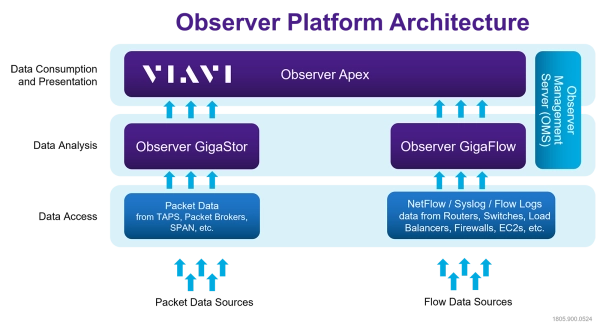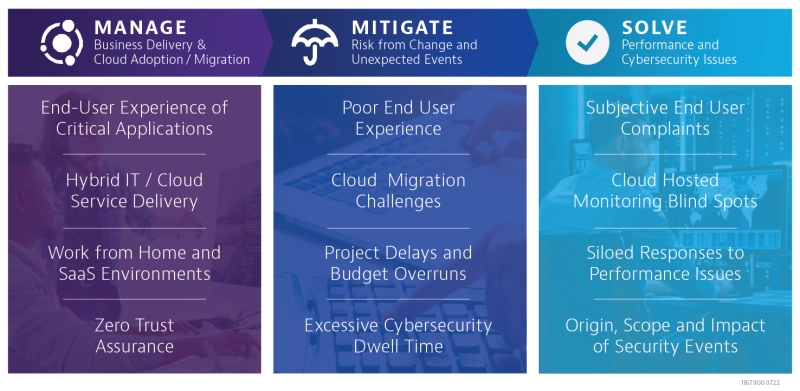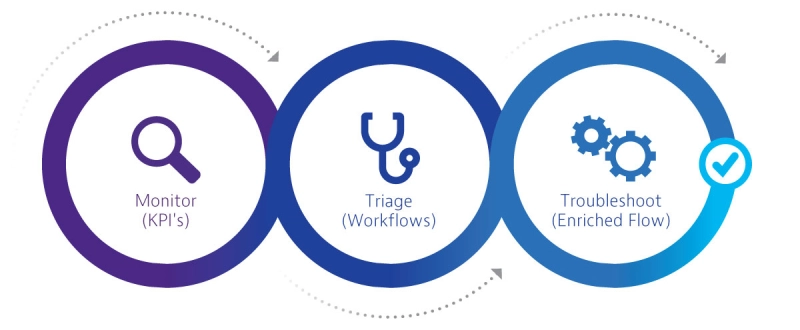Network Performance Monitoring
Proactive monitoring for enhanced network health and observability
Mastering Network Performance: A Simple Approach to Navigating Complex IT Landscapes
Network teams often find themselves overwhelmed, trying to stay ahead of a myriad of complaints, logs, and reports. The key difficulty lies in pinpointing the real source of network issues, especially in an era dominated by decentralized networks, the Internet of Things (IoT), SD-WAN, and the layered configurations of hybrid and private cloud solutions.
With the rise of work-from-home (WFH) models, remote employees in various locations frequently use cloud applications, often bypassing the traditional data center route. This shift underscores the urgency for comprehensive infrastructure monitoring and a deeper insight into the experience of remote end-users.
The evolving landscape of Network Performance Monitoring (NPM) and Management is marked with key trends driven by increasing complexity.
These trends include:
- Adapting to Expanding Network Tiers and Hosting Locations: As network tiers expand, the hosting landscape now encompasses multi-cloud and external geographic sites along with traditional deployments. This requires a dynamic approach to NPM, adapting to the varied needs of different hosting environments.
- Addressing Visibility Challenges with Remote Users and WFH Users: The surge in remote and work-from-home users has created unique visibility challenges. They often access network resources outside the traditional enterprise environment, connecting directly to cloud-based applications and often bypassing traditional data centers.
- Leveraging Software as a Service (SaaS): SaaS brings a convenient, cloud-based model for delivering application software, configuration services, and automated updates to consumers and businesses. This trend benefits users with its ease of deployment and advanced security features, ensuring robust network performance and security in a cloud-centric world.
The VIAVI Approach – Streamlining Network Performance with Innovative NPM Tools
Network Performance Monitoring (NPM) tools from VIAVI are tailored for proactive network issue resolution, combining advanced end-user experience scoring, logical diagnostics, and intuitive workflows. The comprehensive storage of all packet and flow data offers the in-depth analysis necessary for thorough forensic investigations. This enables IT teams to quickly uncover and address network performance issues and implement corrective measures before any significant downtime occurs.
In an era where technological innovation, strategic cloud migration, and digital transformation are paramount for organizations to stay competitive, IT teams are tasked with balancing business innovation with operational excellence. Our NPM solutions help facilitate operational efficiencies and enable IT teams to pivot toward digital innovation and proactive strategies.
Further, this approach includes managing daily operations, mitigating risks from both planned and unplanned events. It empowers IT teams with the tools to swiftly identify performance issues, enhancing their ability to quickly implement effective solutions. The solutions also provide enterprise-wide situational awareness and real-time observability into network health, offering essential visibility for mitigating risks linked to network expansion and unforeseen challenges.
The VIAVI Value: Transforming Network Performance Management with Expert Solutions
The VIAVI Observer Platform, an industry leader in Enterprise NPM solutions, represents a significant advancement in network management. It features sophisticated, pre-defined workflows and high-level dashboards ideal for complex network environments. With its unique patented machine learning-powered automated End-User Experience (EUE) Scoring, it provides real-time observability into network performance, enabling IT teams to directly correlate network behavior with real user impacts.
These solutions can help identify and remediate key challenges in network visibility, technological integration, and asset management, aligning seamlessly with strategic business objectives. This fusion of advanced functionality and business-focused design exemplifies the VIAVI commitment to elevating network performance management across diverse organizational landscapes.

Observer provides in-depth visibility into the health and performance of vital IT tools, focusing on network monitoring from the end-user perspective. This unique approach empowers network and operations teams to ensure seamless application delivery and robust IT services. Below are three key use cases integral to improving user experience and network functionality, reflecting this strategy's alignment with high-level observability and performance goals:
- Manage Business Delivery & Cloud Adoption/Migration: The Observer Platform improves visibility into the end-user experience for vital applications, remote work environments, and modern cloud deployments. This allows IT teams to adopt a more proactive stance, to help facilitate better cloud service delivery and strengthen security within hybrid environments.
- Mitigating Risks from Changes and Unexpected Events: Observer's network performance monitoring capabilities are pivotal in helping to reduce risks, frequency, and impacts of unexpected events and continuous changes, including challenges like project delays, regulatory compliance issues, or security-related remediations. A key aspect of this strategy is the pre/post cloud migration assessment and benchmarking.
- Solve Performance and Cybersecurity Challenges: VIAVI Observer overcomes the blind spots caused by cloud-hosted applications, simplifying the identification of the source, extent, and impact of security and performance issues. It counters this by replacing isolated responses and subjective user feedback through comprehensive end-to-end network visibility and predictive intelligence.


Literatura
Vídeo
Seminario en línea
Déjenos ayudarle
Estamos a su disposición para ayudarle a avanzar.



